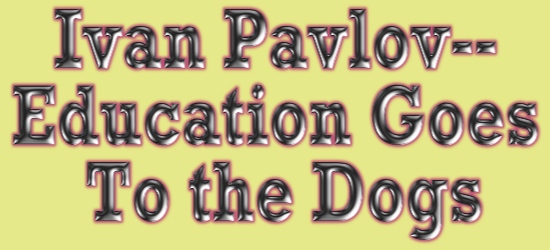27: Ivan Pavlov-- Education Goes To the Dogs

|
Try--à la Proust--to remember that exact magical moment when you first heard about Dr. Pavlov and his salivating dogs.
In
high school possibly; college more likely. Can you recall the speaker’s tone, the mood in the room??
My own first time came back to me very strongly a month ago. Quite Proustian. It was as if I were there, in a college lecture
hall, hearing what the Russian scientist had achieved.
I didn’t see the speaker. I saw the feelings. Triumph!! Celebration!!
I was hearing glorious news that would forever change the world. Dr. Pavlov sounded a bell, and had thereby “made”
a dog to salivate. Wonderful!
|
At the time, many years ago,
I had no other thought, no counterweight. A month ago, I did. I suddenly asked myself: so the dog salivated? so what? what
does this really mean? In a flash, I concluded that Pavlov had merely tricked the dog. He rang a bell every time the dog got
food; naturally the dog connected the bell and food. Imagine yourself in a prison cell, isolated, underfed, no clocks. Once
each day a bell sounds and then a food cart arrives. Naturally, you conclude the bell is a signal from the kitchen, or a signal
to the guards, something like that. You’re hungry. Your body wants to be ready to start digesting that food. The spit
flows! That’s biological efficiency, it seems to me.
|
|
|

|

Note colecting tube outside dog's mouth.
|
|
Think about it. You--or the
dog--would have to be brain-dead not to make some connection, some association. Any animal above a shrimp would think: here
comes the grub! Indeed, this famous experiment seems to me to show the opposite of what is claimed. Not a robot or an automaton
at all, that dog is showing intelligence. And imagination. He is carefully watching his environment and making shrewd calculations.
The same ones you would make! As I say, all that Pavlov did was to lie to the dog. Here’s food five times, then no food.
Fooled ya! If he did it to you, I bet you’d feel really betrayed.
|
|
Which brings us to the question
that has started to haunt me. Why were so many people so thrilled about this trivial little bit of trickery and manipulation?
How do we explain the celebratory mood? The answer, I believe, is that Pavlov showed a coterie of lab-coated Psychologists
something they were desperate to believe: that humans could be conditioned and controlled, that they could be made to do what
the men in the white lab coats wanted them to do. We have to ask: who’s salivating more here, the dogs or the Psychologists?
|
|
Q.E.D.: psychologists can deceive; dogs can deduce
|
We might also wonder: what
kind of person wants this kind of control? I certainly do not. Normal people don’t, I submit, want to be in control
of other people. But let me assure you: these early Psychologists a century ago, and their colleagues in the new field of
Education, did want control. With it they believed they could re-design humanity to their own superior specifications.
There were as well other groups who yearned for more control: managers, commissars, social engineers, totalitarians,
anyone eager to build a collectivist utopia. Or a 1984. Now they could create new kinds of humans, in new kinds of societies.
Brave New Worlds opened before their bedazzled eyes.
|
Isn’t it amazing? All
of these people elated by a single small experiment with dogs, an experiment that mainly dealt with a dog’s physiology,
with its automatic systems. I believe a huge sophistry occurs at this point. An experiment on a dog’s body is passed
off as proving something about its mind--and indeed, human mind! It seems to me that overreach and oversell were big parts
of this story from the get-go; hype and hysteria became permanent motifs. These people wanted Pavlov’s experiment to
mean something really big. So they pretended that it did. This experiment was their ticket to control in lab or classroom,
their passport to power over members of a society, and their guarantee of fame and success as the founders of a new science.
Thus the jubilant mood that, very probably, you also felt the first time you heard about Pavlov.
|
| |
Pavlov did his work
in the 1890s and 1900s. It exactly resonated with, and seemed to confirm, the sensibility then emerging in Europe and America.
Already by 1908 an early educator named Edward Lee Thorndike published a book called “The Principles of Teaching Based
on Psychology” which announced: “The aim of the teacher is to produce desirable and prevent undesirable changes
in human beings by producing and preventing certain responses.” See anything there about learning or facts or knowledge?
Apparently teachers are no longer to be concerned with such stuff. See anything in that quote about a student’s character,
self-discipline, judgment, or reasoning? No, the emphasis is entirely on responses, which the teacher would “produce.”
Everything was clear now. Schools should be like laboratories. Students should be like Pavlov’s dogs. Education is
just a matter of making kids salivate when you want them to.
|
|
Historical footnote: in 1896 John Dewey founded his famous LABORATORY SCHOOL at the University of Chicago. For more on Dewey, see Article #25.
|
Let me interject some notes
in Pavlov’s defense. He himself did not use the phrase “conditioned reflex,” which sounds quite fixed. He
used the Russian phrase meaning “conditional reflex.” A little looser, you see; the bell and the spit are there
together. But the English translation adopted the sterner “conditioned reflex,” which sounds like imprisonment,
the stockade, a sure domination--the dog must salivate; the doctor makes it happen.
Here’s a second point
worth knowing: the whole thing was accidental and empirical. Pavlov noticed that when workers, in their standard uniforms,
showed up with food or without food, the dogs started to salivate. Hmm, might be worth measuring. Pavlov was first of all
a specialist in digestion and a surgeon; he was able to implant little tubes in a dog’s mouth. So he could quantify
the amount of spit. Probably it was the bell (he used many other signals) that captured the public’s imagination. Bell
rings, dog salivates. What greater bondage could there be?! But as we see, he did not set out to prove what he supposedly
proved; and his own language suggests he did not say he had!
|
|
But some seemed to imagine
that Pavlov’s work with dogs had fulfilled a world-view. The desire was there--the hunger, the need--to put people in
straightjackets and control them. For the good of society. Pavlov made the whole process seem scientific. If you could do
it, the Psychologists seem to be thinking, then it was good to do. It must be part of Nature’s plan.
|
Looking back, I believe we
can see that Psychology was way out on a limb from the start. It pretended to be a science, which it is still not. It promised
total understanding of human behavior, which it hardly ever approached. One shoddy intellectual device used in this pursuit
was a massive reductionism--just ignore and discredit anything that doesn’t fit, or that won’t allow itself to
be controlled. Ignore, for example, genetic inheritance, personal philosophy or religious belief. Focus only on behaviors.
Reduce the world to bells and spit, or various equivalents thereof. A merry band of white-coated shrinks simply declared that
the world was materialistic and mechanistic; people are mere animals, i.e. machines made of meat; and all you need to do to
control these simple objects is to push the right buttons or ring the right bells.
|
Today, you can go on Google
and quickly research the current understanding of the phrases “conditioned reflex” or “classical conditioning.”
I think you’ll find that the presentations are weirdly mathematical, as if a theorem is being discussed. Do X, get Y.
A + B = C. Usually there are diagrams. Why, it’s just like the law of gravity, these descriptions seem to suggest. I
can’t escape the sensation that this is more pseudo-science than science. (I’m reminded of the vast apparatus
said to prove that Whole Word was the only way to teach reading, when in fact it could not teach reading. See #21 on this
site.)
|
|
AND IN CONCLUSION...
|
|
My concern is with education and in trying to understand why so-called “progressive” educators took us so far
afield starting a century ago. Pavlov was part of this story, but I don’t think a very big part. He provided fuel for
a fire that was raging and would go on raging. He helped the marketing. His research was minor, but the reports issued to
the world had a certain crystalline purity: a dog and a bell. An unforgettable image.
The early Educators/Psychologists (the same people founded both fields ca. 1890) needed dramatic proof for their premises
and conclusions, so they acted as though Pavlov had provided all that. The more you look at this thing, the more perplexed
you’ll be. A bell and a dog? How does this experiment even extend to education? Where is even the smallest relevance?
What are you going to do--starve the students and give them pellets of food to make them learn? Education is properly concerned
with students learning to use their intelligence, logic, judgment, knowledge and experience to understand the world. What
kind of person (I have to ask) equates all that with salivating?
© Bruce Deitrick Price 2011
|
|

cartoon by Mark Stivers
|
RELATED ARTICLES: "15: 1984 -- The
Cover Up" and "21: A Tribute to John Dewey" (sections 2 and 3)
|
|